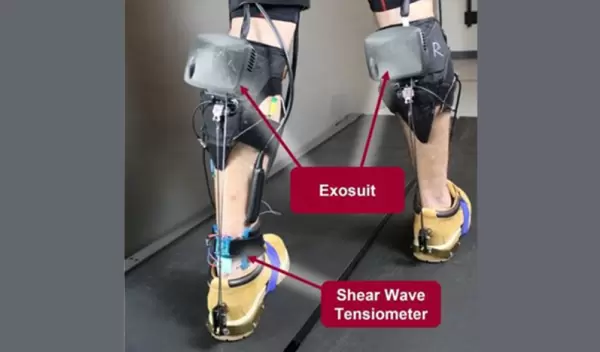
Wearable sensor can help unlock the potential of exosuits in real-world environments
Wearing an exosuit could help people recover from an injury or give extra help for carrying heavy loads. But, according to University of Wisconsin–Madison and Harvard University researchers, not everyone who dons a wearable robot today can immediately reap benefits from the assistance.
Creating the desired effect on an individual wearer was challenging — there wasn't a good way to directly measure the changes in loading on muscle and tendon tissue that occur when a person uses an exosuit.
The research team has met that challenge, employing a unique wearable sensor called a shear wave tensiometer. The simple, noninvasive device is easily mounted on the skin over a tendon. The tensiometer enables researchers to directly assess tendon force by looking at how the vibrational characteristics of the tendon change when it undergoes loading, as it does during movement.
The researchers performed rigorous biomechanical experiments in the lab. These systems are worn on the body and portable, allowing the team to conduct additional outdoor tests to demonstrate real-world viability.
The findings underscore the importance of customizing an exosuit to its user so that it can be more useful in real environments.
"Different people are going to react to an exosuit in different ways, so we can't assume that there is a one-size-fits-all exosuit controller that is going to work for everyone," says Dylan Schmitz, a UW–Madison mechanical engineer, NSF Graduate Research Fellow and co-first author of the paper. "This research highlights the importance of taking direct measurements of muscle and tendon forces to ensure that an exosuit is causing the expected biomechanical changes."
The study was supported by two grants from the U.S. National Science Foundation Graduate Research Fellowship Program and two grants from NSF's Disability and Rehabilitation Engineering program. The results are published in Science Robotics.
Commenting on the research, NSF Program Director Grace Hwang said, "This study is the first that directly measures the Achilles tendon force on individuals wearing an exosuit while they walk in an unconstrained outdoor environment. This knowledge can assist with locomotion for people with mobility impairment and is an important step for understanding the effectiveness of personalized wearable robotic systems."
